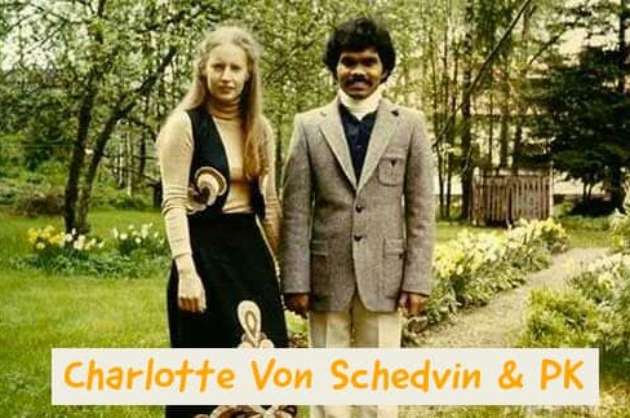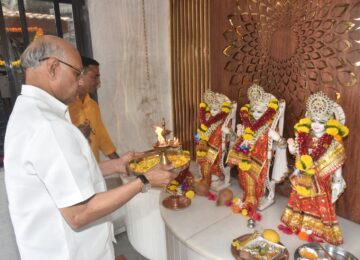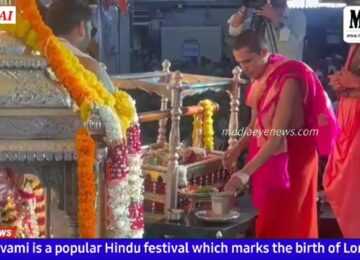Swami Madhava Chaitanya,
An “Untouchable” From India Fell in Love with an Aristocrat and Proved to the Entire World That Love Has No Boundaries.
True love knows no bounds and this is exactly the story of a poor man from India, Dr. Pradyumna Kumar Mahanandia (fondly known as PK), and Charlotte Von Schedvin, a royal from Sweden.
It is not a movie love story, it is a real love story that happened recently. This is a remarkable true story of how love and courage led PK to overcome extreme poverty, caste prejudice, and adversity – as well as a 7,000-mile, adventure-filled journey across continents and cultures – to be with the woman he loved.
The life story of Dr. PK. Mahanandia and how he came over the hardships in life with determination will inspire us. Pradyumna Kumar Mahanandia, usually referred to as Dr. P. K. Mahanandia or PK was born in 1949 in an Odia-speaking Dalit weaver family in the village of Kandhapada of the Athmallik sub-division in the district of Angul, India's northeastern state Odisha. His village was in the bank of one of the largest Rivers In India the Mahanadi river. PK was born in a place between the river and the mountains. Dalit is a very lower cast in the Hindu religion. The meaning of Dalit id "broken/scattered" in Sanskrit and Hindi. It is a term used for people belonging to castes in India who have been subjected to untouchability.
PK did not get justice in his own country and did not get justice from his own religion. He was born in a poor family, the poverty gave him a lot of pain in his life. It was not only poverty that PK faced, but it was also the racial untouchability of his religion that put him to the most severe test. PK faced both of those with dignity; it was three foreign women who helped PK win the battle of life, one of whom became PK’s life partner. Equality in human beings still exists as a mere concept. Poor and rich, black and white, upper cast and lower cast, east, and west, discrimination in human society can be found in every section. In my personal experience, this discrimination has deep roots in Indian society. Independent Indian constitution is promising equality for all Indians, but the reality is different. I think PK life story will make us think about the cruel discrimination.
Indian north east State Odisha also formerly known as Orissa, has a great heritage in ancient Indian history. Puri Jagannath Temple and Konark Sun temple are world-famous. Odisha was a very great cultural economic and military power in ancient times. Odisha has a great influence on Buddhist religion history too. The ancient name of this state is Kalinga, The ancient kingdom of Kalinga was invaded by the Mauryan emperor Ashoka (which was again won back from him by king Kharavela in 261 BCE ) resulting in the Kalinga War(ended c. 265 BCE). The empire was the largest political entity that had existed in the Indian subcontinent, extending for over 5 million square kilometers (1.9 million square miles) at its zenith under Ashoka. Kalinga war changed Emperor Asoka's life forever. The bloodshed of this war is said to have prompted Ashoka to adopt Buddhism. Ashoka had seen the bloodshed and felt that he was the cause of the destruction. The whole area of Kalinga was plundered and destroyed, hundreds of thousands of people dead on both sides. Asoka’s response to the Kalinga War is recorded in the Edicts of Ashoka. The Kalinga War prompted Ashoka, already a non-engaged Buddhist, to devote the rest of his life to ahimsa (non-violence) and to dharma-Vijaya (victory through dharma). Following the conquest of Kalinga, Ashoka ended the military expansion of the empire and began an era of more than 40 years of relative peace, harmony, and prosperity, Emperor Asoka was the main reason why Buddhism spread over the whole Indian continent and other parts of the world.
Emperor Ashoka's great grandfather and founder of Maurya emperor Chandragupta Maurya was one of the Great emperors in modern Indian history. Chandra Gupta Maurya's life was influenced by a western beautiful princess Helen. Chandragupta Maurya defeated Seleukos Nikator the commander in chief of Alexander the great and the ruling Emperor of Persia in 305 B.C. It was a political alliance in which Helena the daughter of Seleukos Nikator and Macedonian Princess married Chandragupta Maurya, the Emperor of India and the Mauryan Empire. It is believed that Chandragupta waged a war against Seleukos Nikator so that he could marry Helena. The story goes that one day Chandragupta was going with his guards on a horse when he saw Helena and her friends playing near a river. Chandragupta was attracted to this young lady and fell in love with her.
Though the father of Helena was against the marriage as Chandragupta was not a Greek yet Helena was attracted to Chandragupta and advised her father to arrange her wedding to him. Helena must have been in her 15-17 years when she was married off to Chandragupta Maurya who was 40 years then. Helena was the daughter of Seleukos and his Persian wife.
Helena became a quiet Indian after marriage to Chandragupta Maurya. She learned Sanskrit and Classical Indian music. She became his chief consort and Empress of the Mauryan Empire. I hope to write the love story of great Greek beauty princess Helen and the great Indian Emperor Chandragupta Maurya very soon,
There is another beautiful love story between east and west, an Indian very common man PK loved a very rich Swedish girl Von Schedvin and they got married in an unimaginable way.
I will reveal the beautiful love story in upcoming articles.
Next part of this life inspirational story will upload soon




























